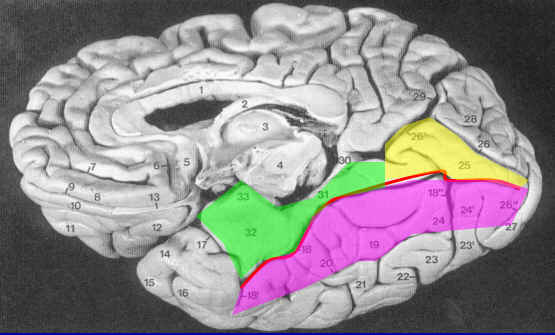Fusiform gyrus
From Psy3242
Fusiform Gyrus is highlighted in pink above
The Fusiform Gyrus is a long spindle-shaped gyrus that is on the medial surface of each temporal lobe, at the connection of the occipital lobe which contains area V4 of the visual cortex. It is segmented medially by the collateral sulcus from the lingual gyrus and the anterior parahippocampal gyrus, laterally by the inferior temporal sulcus from the inferior temporal gyrus. Other names used for this brain area are: Gyrus Occipitotemporalis, Gyrus Fusiformis, lateral Occiptotemporal Gyrus, and Lobulous Fusiformis.
Function
There is still some argument about the extent of the functioning of the fusiform gyrus, however, there are a few functions that are agreed upon. The fusiform gyrus has a part in processing color information. It plays a role in face and body recognition (with the fusiform face area). It also plays a role in symbolic processing through word, number, and abstract recognition. Thus, it does processing for a variety of different things; its functioning appears to be strictly recognition of these items. The amount of the items that are recognized by this area may be much larger than has been discovered so far.
Parts of the Fusiform Gyrus
Recent research has findings that suggest there are at least two part of the fusiform gyrus devoted to separate processing. The two separate portions of the fusiform gyrus showed distinctive activity levels to patterns of letters. The first region, more anterior in the brain, responded comparably to all types of letter strings. However, it did not to illustrations or visual patterns. The second area, which is more posterior in the brain, was only activated during presentations of actual words. Thus, there is support that there is a Visual Word Form Area in this gyrus. With more research it may be found to have even more separate processing areas within the fusiform gyrus.
Disorders
There may be connections between prosopagnosia, the inability to recognize faces, and the fusiform gyrus.

